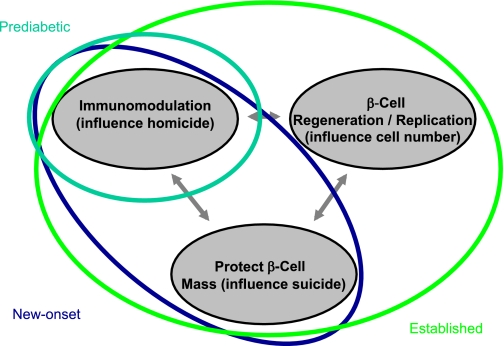FIG. 6.
An idealized model illustrates intervention in type 1 diabetes by the degree of disease state and improved knowledge of understanding the role of β-cell homicide (i.e., immune-mediated death) and suicide (i.e., mechanisms that contribute to cellular death) in the processes underlying the formation of this disorder. Subjects would, theoretically, be placed into different means and methods of therapy by the status of their disease state, such as prediabetic, new-onset diabetes, or established diabetes. On the basis of our understanding of the natural history of diabetes, an increasingly intensive intervention may be required to provide therapeutic benefit to those with this disease. For example, in those with ongoing anti–β-cell autoimmunity but who lack overt type 1 diabetes (aqua line), therapy with a single agent capable of restoring immune tolerance and disrupting immune-mediated death may be beneficial. However, for patients with new-onset disease (blue line), combination therapy that provides an agent capable of restoring immune tolerance along with a drug that preserves and protects the remaining β-cells may prove ideal. Finally, for the patient with established (i.e., long-term) type 1 diabetes (green line), a three-way combination therapy that includes the aforementioned agent forms with a therapy capable of inducing β-cell replication/neogenesis may prove most beneficial.

